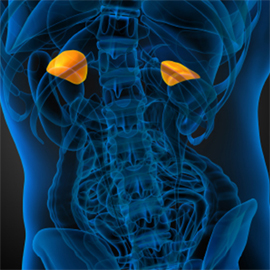
A subgroup of women with polycystic ovary syndrome (PCOS), a leading cause of infertility, may produce excess adrenal hormones, according to an early study by researchers at the National Institutes of Health and other institutions.
PCOS is a group of symptoms related to high levels of hormones known as androgens. In many women with the condition, the ovaries contain numerous small, cyst-like sacs. Women with PCOS may have irregular, missing, or prolonged menstrual periods, excessive facial and body hair, insulin resistance, and problems with fertility. Treatment may include drugs that block androgens, and oral contraceptives, which contain the hormones estrogen and progesterone.
“Traditionally, treatment for PCOS has included modifying ovarian hormones,” said Constantine Stratakis, M.D., director of intramural research at NIH’s Eunice Kennedy Shriver National Institute of Child Health and Human Development (NICHD) and senior author of the study. “Our findings indicate that a subgroup of patients could conceivably benefit from modification of adrenal hormones as well.”
The study was published online in the Journal of Clinical Endocrinology and Metabolism. The study’s first author is Evgenia Gourgari, M.D., of Georgetown University, Washington, D.C., who was a research fellow at NICHD when the study was conducted.
In their article, the researchers noted that earlier studies had found that in some women with PCOS, androgens were produced by the adrenal glands, rather than by the ovaries. On the basis of these observations, the researchers decided to test the adrenal functioning of women with PCOS.
A total of 38 women with PCOS volunteered for the study, along with 20 healthy women, who served as a comparison, or control group. They studied the PCOS patients’ adrenal functioning with a diagnostic procedure known as Liddle’s test, used to diagnose disorders of the adrenal glands. The test consists of a two-part sequence in which women take the drug dexamethasone, which mimics the adrenal hormone cortisol, first in a low dose and then in a high dose. At the end of the test, people with disorders of the adrenal glands often will produce high levels of adrenal hormones.
The researchers found that 15 of the 38 PCOS patients produced more adrenal hormones than normal. The women also had adrenal glands that were smaller than normal.
The researchers theorize that the women’s adrenal glands may resemble those seen in a condition called micronodular adrenocortical hyperplasia—in which tiny lumps or nodules appear on the adrenal glands and begin producing adrenal hormones. Because the nodules produce hormones, the adrenals produce fewer hormones and shrink.
Dr. Stratakis added that additional studies with a larger number of patients will be needed to examine the adrenal glands of women with PCOS to confirm the study results and to determine whether the women have micronodular adrenocortical hyperplasia or some other condition affecting the adrenal glands.
Citation: Gourgari, E., et al. “Bilateral adrenal hyperplasia as a mechanism for hyperandrogenism in women with polycystic ovary syndrome. ” Journal of Clinical Endocrinology and Metabolism. Published online: Journal of Clinical Endocrinology and Metababolism. jc20154019.
###
About the Eunice Kennedy Shriver National Institute of Child Health and Human Development (NICHD): The NICHD sponsors research on development, before and after birth; maternal, child, and family health; reproductive biology and population issues; and medical rehabilitation. For more information, visit the Institute’s website at http://www.nichd.nih.gov/.
About the National Institutes of Health (NIH): NIH, the nation's medical research agency, includes 27 Institutes and Centers and is a component of the U.S. Department of Health and Human Services. NIH is the primary federal agency conducting and supporting basic, clinical, and translational medical research, and is investigating the causes, treatments, and cures for both common and rare diseases. For more information about NIH and its programs, visit http://www.nih.gov.

 BACK TO TOP
BACK TO TOP